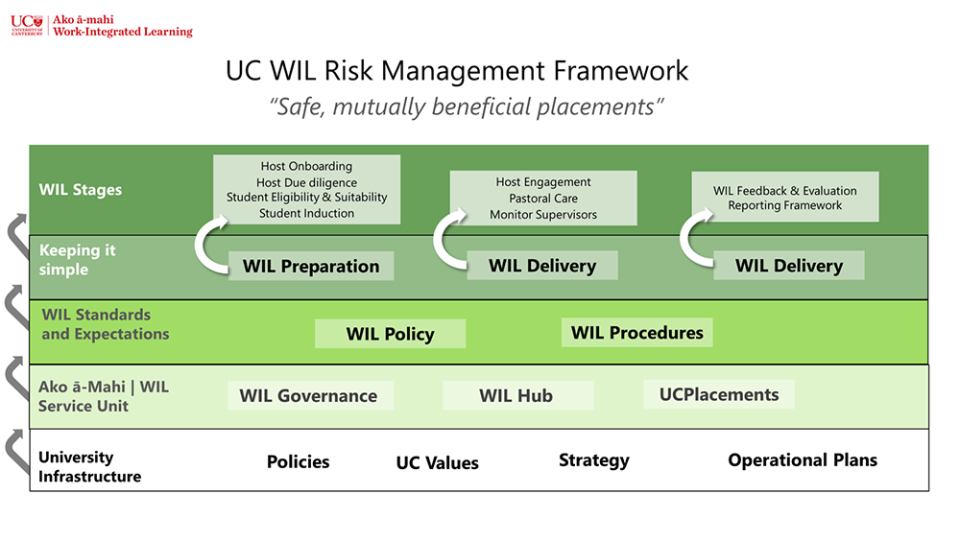
Where there’s WIL, there’s risk
As demand for universities to support work-integrated learning rises, so does exposure to potential pitfalls such as personal injury and reputational harm. What can higher education institutions do to mitigate the risks?
You may also like
Popular resources
Work-integrated learning (the “WIL” of the title) is considered integral for students’ skills, employment prospects and understanding of the world of work, but its expansion is not without risk. In prioritising WIL, universities must balance the demands of students and employers, government education agencies’ focus on work-ready graduates, and expectations of other stakeholders with protections against, for example, personal injury or reputational harm.
Consider the potential risks to students of work-related stress, discrimination or lack of preparedness while on placement. Consider also the legal or reputational risk to universities of falling short of their shared responsibility for the health and safety of such students or the more subtle risk of not ensuring that a place of work provides an effective and suitable learning environment.
- Spotlight collection: enhancing employability through higher education
- What support students need to succeed in work placements
- Three tips for using capstone projects to improve employability
So what can be done to mitigate the potential pitfalls for students, employers and higher education institutions?
For many universities, including the University of Canterbury (UC) in Aotearoa New Zealand, total risk avoidance is not an option. So risk management was the principal focus when we developed our institutional WIL risk-mitigation strategy.
To help others growing WIL at their university, especially those nervous about the “how”, here are examples of what we implemented to help mitigate WIL-related risk at UC.
Create a centralised WIL hub: Ako ā-mahi (‘learning through working’)
A WIL hub can be an intentional component of a risk-mitigation strategy. It is a way to bring education, training, technology and resources (based on WIL research) together in one place to support staff, students and host organisations to experience high-quality WIL. Under the auspices of the deputy vice-chancellor (academic), UC’s WIL hub has given staff a solid platform to advocate for, and advise on, good WIL practice.
For WIL coordinators, the hub provides advice and resources to improve operational efficiencies, including the use of templates, risk diagnostic tools and placement-matching software. The hub also advises on host organisation relationship development and maintenance to create sustainable WIL programmes. For academic staff, the hub provides bespoke pedagogical advice to course coordinators who either want to create a new WIL course or improve an aspect of an existing WIL course. A flagship suite of interdisciplinary internship courses – PACE (professional and community engagement) – are open to all students and are an exemplar of good WIL practice. The PACE courses can be adopted or adapted by faculty for their own purposes. These hub activities increase WIL literacy at UC, which is itself a risk mitigant.
Overview of our risk-mitigation journey
When we created the hub, we developed a high-level risk-mitigation process for WIL. The key phases of the process (which sometimes occurred concurrently) included:
- a deep analysis of current international literature on mitigating risk in WIL (including legal, strategic, operational, reputational, ethical and financial risk)
- a thorough review of relevant legislation (which in New Zealand strongly emphasises health, safety and well-being)
- the creation of a risk matrix and a list of associated WIL safeguards (in essence, a detailed matching exercise of the resources and actions we needed to apply, or develop, to respond to identified legal risk). One example of a WIL safeguard was the creation of an improved tripartite WIL agreement for students, a host organisation and UC in relation to unpaid internships that included standardised terms and conditions clarifying roles and responsibilities of each party, from privacy and confidentiality to pastoral care expectations
- setting up a WIL risk working group to analyse and evaluate WIL risk from an institutional perspective
- consultation with WIL practitioners from all UC faculties (Science, Business, Arts, Health, Engineering, Law and Education) together with legal, risk and insurance teams. This provided endorsement that new safeguards, such as pan-UC WIL procedures, would help staff towards institution-wide understanding of what good risk management looks like
- working systematically with WIL practitioners in each faculty to use placement-management software that seeks to transform the task of placing students into workplace settings from labour-intensive and unsystematic to fluid, effective and scalable. As we do this, we help kaimahi (staff) assess and mitigate risks pertinent to their discipline.
Establish WIL policy and separate WIL good practice guidelines
Getting everyone’s buy-in to WIL policy and guidelines will entail drafts and debate, but tenacity will be rewarded. Amid discussion, predominantly around how to maintain diversity of practice in WIL while trying to apply universal rules – think of nurses in clinical placements, law students in professional services firms, or geography students close to volcanoes – you may begin to wonder whether institution-level standards are realistic.
Can you apply a one-size-fits-all approach? The short answer is “no”.
Instead, we created a simple policy that established the scope of WIL at our university, and set out the roles, responsibilities and accountabilities shared among the many internal and external stakeholders involved in WIL. Our good practice guidelines then became more about “this is what we expect from you in the preparation, delivery, review and improvement of WIL”. The guidelines also take staff to useful resources such as student handbooks, partner handbooks, risk assessment tools and WIL template agreements.
A WIL risk-management framework
Given the complexity of engaging in WIL – and the elephant in the room (that WIL is perceived as resource-heavy and fraught with risk) – a visual framework can be helpful to reassure staff that WIL doesn’t happen in a vacuum. The visual tool illustrates that risk mitigation builds on university infrastructure, values and strategy (in UC’s context, its dedication to building student employability skills) as well as the part staff play, from skilful matching of students with opportunities to due diligence of host organisations.

The right technology used effectively
New placement-management software has been effective in UC’s meeting legal obligations, and transformative in giving staff back valuable time to attend to more student-centric activities. It has also provided a way into conversations about quality WIL more generally. This system provides us with an enterprise view of where our students are expected to be while on placement, as well as enhancing operational efficiencies and extending administrators’ capabilities and capacity. Rolling out this software also opens doors with colleagues throughout the university, across a range of WIL-related subjects.
Two ways in which the system already shows dividends are: reducing key person risk as we no longer lose our intellectual property when staff walk out the door at night; and in case of emergency, we can identify where each student should be and who is responsible for them at the press of a button.
A path to WIL risk literacy
From starting a conversation about meeting the basics of supporting students in workplace settings, relationships can often be fostered among WIL hub staff (professional, academic and technical) with course coordinators towards a “Have you thought about…?” conversation, ranging from developing the authenticity of the WIL experience and specific workplace competencies to assessment design involving the host organisation.
The kōrero (conversations) we had along the way in providing technology, and creating resources and documentation, has enabled more than developing risk literacy among our colleagues at UC. For us in the UC WIL hub, it has been a chance to appreciate the depth, diversity and innovation relating to WIL across faculties and disciplines. By ensuring that we have a working institutional risk-mitigation strategy, we can ensure that the strategic value of WIL to our university is fully realised.
Clare Murray is director of work-integrated learning | Ako ā-Mahi in the Office of the Deputy Vice-Chancellor – Academic at Te Whare Wānanga o Waitaha | University of Canterbury.
If you would like advice and insight from academics and university staff delivered direct to your inbox each week, sign up for the Campus newsletter.





Comments (0)
or in order to add a comment